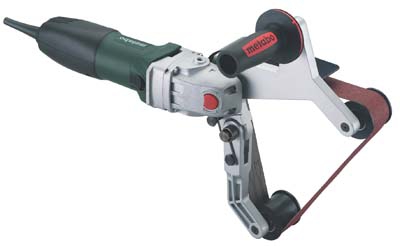
Metabo Corp. offers an electronic pipe and tube belt sander for burnishing, finishing and reconditioning steel, stainless steel, non-ferrous pipe and tube. The RBE12-180 Pipe and Tube Belt Sander is a flexible tool that adapts to contours and is easy to handle. This versatile tool can render weld seams invisible and can give stainless steel a mirror finish.
The RBE12-180 features Metabo's Marathon motor with 1,200 W and 10 A of power, double gear reduction for a high rate of material removal, an exact sanding belt guidance feature for even grinding results and a 270 degree maximum wrap angle that allows the tool operator to work more efficiently.
The new pipe and tube finisher includes Metabo's VTC (Vario Tacho Constamatic) electronic speed stabilization for increased productivity under the heaviest operating conditions, electronic soft start and thumbwheel to preselect the tool's speed. The RBE12-180 features a toolless sanding belt exchange that helps to increase operator efficiency and safety.
Additional safety features include overload protection, power interruption protection, Metabo's winding protection grid and long life auto-stop carbon brushes.
The RBE12-180 has an extensive range of accessories for various materials and can be used to take metals from a welded or mill finish to mirror finishes.
Contact Details
Related Glossary Terms
- burnishing
burnishing
Finishing method by means of compressing or cold-working the workpiece surface with carbide rollers called burnishing rolls or burnishers.
- grinding
grinding
Machining operation in which material is removed from the workpiece by a powered abrasive wheel, stone, belt, paste, sheet, compound, slurry, etc. Takes various forms: surface grinding (creates flat and/or squared surfaces); cylindrical grinding (for external cylindrical and tapered shapes, fillets, undercuts, etc.); centerless grinding; chamfering; thread and form grinding; tool and cutter grinding; offhand grinding; lapping and polishing (grinding with extremely fine grits to create ultrasmooth surfaces); honing; and disc grinding.
- milling machine ( mill)
milling machine ( mill)
Runs endmills and arbor-mounted milling cutters. Features include a head with a spindle that drives the cutters; a column, knee and table that provide motion in the three Cartesian axes; and a base that supports the components and houses the cutting-fluid pump and reservoir. The work is mounted on the table and fed into the rotating cutter or endmill to accomplish the milling steps; vertical milling machines also feed endmills into the work by means of a spindle-mounted quill. Models range from small manual machines to big bed-type and duplex mills. All take one of three basic forms: vertical, horizontal or convertible horizontal/vertical. Vertical machines may be knee-type (the table is mounted on a knee that can be elevated) or bed-type (the table is securely supported and only moves horizontally). In general, horizontal machines are bigger and more powerful, while vertical machines are lighter but more versatile and easier to set up and operate.






